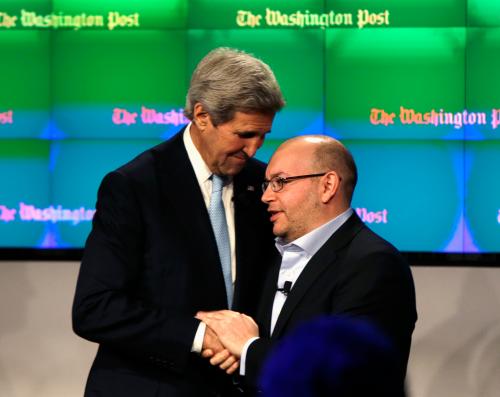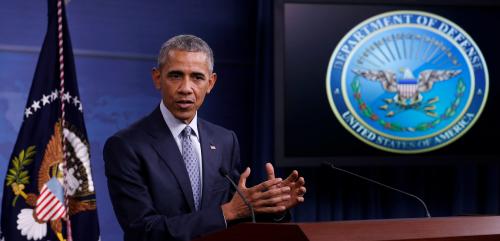On January 17, President Obama commended a trio of nearly simultaneous breakthroughs with Iran as evidence of “what’s possible with strong American diplomacy.” These included Implementation Day, which marked the certification of Iran’s compliance with its initial obligations under the comprehensive nuclear deal and the corresponding lifting and/or waiver of a vast array of international sanctions on Tehran. The administration also announced the release of five Americans detained in Iran and the settlement of a decades-old financial dispute between the United States and Iran.
Nearly nine months later, the last of these three developments—which generated little press at the time—has taken on a new life. The details, however, are not yet well understood, and some aspects of the case remain unclear. This account draws on recent press reports and the testimony of Obama administration officials and others at September hearings before the House Financial Services Committee and the Senate Committee on Banking, Housing, and Urban Affairs.
What happened on January 16 and 17?
In mid-January, the United States was on the cusp of finalizing what a State Department official described as “multiple lines of effort” surrounding Iran. U.S. officials have described the three diplomatic efforts as formally unrelated, but as Department of State Deputy Assistant Secretary for Iranian Affairs Christopher Backemeyer explained, Washington sought to capitalize on “significant diplomatic momentum that allowed us to advance U.S. interests all at the same time.”
On January 16, the U.S. Department of the Treasury began to prepare the payment of the recently-reached settlement. The transaction was put on hold for several hours due to complications regarding the location of Jason Rezaian’s wife and mother—who were in Iran—but by the next day the administration moved forward with the payment and with what administration officials have called a “reciprocal humanitarian gesture.” As Backemeyer explained, “we provided relief to certain Iranian nationals—including several dual U.S.-Iranian nationals—who had primarily been charged with sanctions-related crimes.”
Why did the United States pay Iran?
In the 1960s and 1970s, Iran was the largest partner of the U.S. Foreign Military Sales (FMS) Program. As an Obama administration official explained earlier this year, “As part of the FMS Program, a Trust Fund was established with Iranian funds to pay U.S. contractors as work progressed on the various contracts.” In February 1979, days before the culmination of Iran’s revolution, the United States and Iran agreed to a Memorandum of Understanding (MoU) that halted these payments and voided many of the remaining purchases. The MoU also called for Iran’s unexpended FMS funds to be placed in an interest-bearing account.
Later that year, after Iran’s seizure of the U.S. Embassy in Tehran and the detention of the American diplomats, the Carter administration froze all Iranian assets in the United States. The standoff was resolved nearly 15 months later, with an agreement that freed the hostages and established the Iran-U.S. Claims Tribunal to resolve the labyrinth of financial and commercial disputes that had emerged.
In 1982, Iran filed a claim with the Tribunal pertaining to the FMS Trust Fund, which Lisa Grosh, Assistant Legal Advisor at the Department of State, has described as “a multi-billion dollar breach-of-contract dispute covering 1,126 huge military sales contracts.”
Grosh stated that the two sides engaged in some 40 rounds of negotiations “at this level” over several decades. Iran ramped up efforts to adjudicate the claim in 2015, asking the Tribunal to schedule comprehensive hearings on the outstanding FMS claims and requesting a preliminary ruling. The FMS Trust Fund amounted to $600 million until the George H. W. Bush administration returned $200 million to Iran in a partial settlement in 1990.
Who paid who? And how?
The settlement announced in January involved two parts: return of the $400 million principal and payment of $1.3 billion in interest.
To return the principal, the Treasury, working with the Defense Finance and Accounting Service (DFAS) and the Federal Reserve Bank of New York, made a $400 million wire transfer from DFAS to the Swiss National Bank. The $400 million was then converted into Swiss francs and withdrawn in franc banknotes, which were transferred to Geneva. On January 17, the banknotes were disbursed to an official from the Central Bank of Iran.
The interest was paid from the Judgment Fund, which pays “court judgments and Justice Department compromise settlements of actual or imminent lawsuits against the government.” For a payment to be made by the Judgment Fund, Treasury must receive confirmation from the Attorney General that the settlement is in the United States’ best interests. According to Mary McCord, Principal Deputy Assistant Attorney General, National Security Division at the Department of Justice, “[a]ssessment of a settlement payment from the Judgment Fund includes consideration of the exposure that the United States faces from the claim proposed for settlement, … likelihood of an adverse ruling against the United States, the likely size of such an award, the background of the litigation, the tribunal, relevant legal arguments, relevant facts and governing legal doctrines.”
Since the Judgment Fund does not allow the processing of individual claims of amounts over ten digits, the agreed upon interest—$1.3 billion—was split into 13 claims of $99,999,999.99 and one claim of the remaining $10,390,236.28. These amounts were transferred from the Judgment Fund to the Dutch National Bank, where they were converted into euros and withdrawn in euro banknotes. The Dutch bank then disbursed the notes to a representative from the Central Bank of Iran.
Why was interest paid?
The 1979 MoU stipulated that the unexpended funds would be placed in an interest-bearing account. As it turns out, these funds were not based in such an account—no U.S. administration implemented that requirement. The reasons for this are not clear. Former Undersecretary of Defense for Policy Eric Edelman, who testified on this issue before the Senate, noted that the United States “does not let [FMS accounts] accrue interest.”
Still, most if not all other claims before the Iran-U.S. Claims Tribunal have incorporated compensation for accrued interest. This is consistent with the position adopted by the Treasury Department at the outset of the 1979 assets freeze, although in nearly every case the amount of the interest to be paid has been subject to some haggling between Washington and Tehran.
Obama administration officials maintain that a Tribunal decision may have resulted in a much larger judgment on the issue of accrued interest.
Why cash?
This remains the most contested aspect of the episode. In their testimonies, administration officials stated that they were not aware of specific Iranian requests for cash. Instead, they suggested post-deal difficulties in accessing the international banking system influenced their decision. Treasury Department Assistant General Counsel for Enforcement and Intelligence Paul Ahern testified that “cash was the most reliable way to ensure [Iran] received the funds in a timely manner, and it was the method preferred by the relevant central banks.”
U.S. officials have also noted that the terms of the settlement stipulated immediate payment. As Backemeyer stated, “we have seen difficulties with global banks being willing to engage in these particular transactions, and this was the way, this was the mechanism that we felt we could guarantee immediate payment. And that immediate payment was critical to getting the favorable settlement that we did.”
However, several experts and former senior officials have challenged this explanation, noting that wire transfers were utilized before the January payment in a July 2015 settlement of Tribunal claims for architectural drawings and fossils, and that they have been used since for compensating Tehran for nuclear materials in April 2016.
Was the release of Americans unjustly imprisoned in Iran made conditional on the settlement or its payment in cash?
One of the released prisoners, a Christian pastor named Saeed Abedini, has stated that Iranian police told him that he would not be released until another plane landed.
U.S. officials have stated that Abedini’s account is incorrect, insisting that the release of the prisoners was conditioned only on a reciprocal arrangement in which seven Iranians held in the United States on sanctions-related charges were also released, and Washington agreed to drop Interpol arrest warrants for 14 other Iranian fugitives. State Department officials testified that the payment was briefly halted over concerns about the whereabouts of relatives of one of the released prisoners. The administration maintains that the pause was not linked to the cash transaction but was the “prudent” thing to do.
What about judgments due to American plaintiffs in successful lawsuits against Iran?
Several members of Congress have questioned whether the $400 million in the FMS Trust Fund was in fact available to return to Tehran, noting that the 2000 Victims of Trafficking and Violence Protection Act, which was signed into law by President Clinton, required these funds be used to pay judgments against Iran. However, Congress actually paid these victims using an appropriated $400 million. As State Department official Grosh explained, “[the Act] provides that the United States shall be fully subrogated to the extent of the payment… What that means is those claims then become the U.S. government claims.” However, as described in a 2008 Congressional Research Service Report, the Act also “provided that the United States ‘shall pursue’ these subrogated rights as claims or offsets to any claims or awards that Iran may have against the United States.”
The Brookings Institution is committed to quality, independence, and impact.
We are supported by a diverse array of funders. In line with our values and policies, each Brookings publication represents the sole views of its author(s).







Commentary
The United States, Iran, and $1.7 billion: Sorting out the details
October 3, 2016